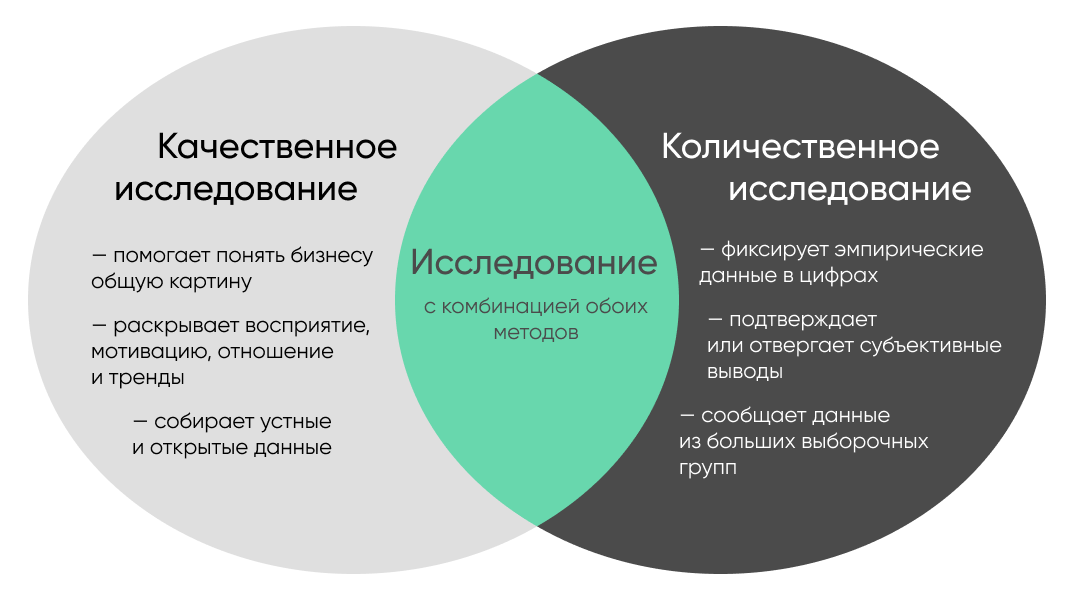I didn’t see it, that means it wasn’t there. We explain to the customer why not only numbers are important in UX research
Hello! I'm Katya Patrikeeva, I work at AGIMA UX researcher. This is a fairly young applied field of business, and I am faced with the fact that different companies have completely different ideas about UX research. One of them is that UX is mostly about qualitative research, which is not as reliable as digital data. In this article I will tell you why this is not so and how you can explain this to the customer.

Myths about qualitative research are a problem for all UX
Sometimes there is a need to explain to the customer the benefits of research, sell or advise a method. To achieve this, it is important to have no bias against qualitative research. A method is just a tool.
If you apply the wrong method to a problem, there will be no result. Agree, if you have a stuffy nose, cough pills will not help you. You need drops. Therefore, cough tablets and nasal drops are just different tools for treating different diseases.
It happens that a customer comes with a demand to conduct a fashion castdev (interview), which will definitely help him, but we see that the problem lies on a different plane. It is clear that if the customer is well versed in both UX and his product, he can himself determine both the problem and the solution. However, not all customers are like this.
In reality, everything turns out to be somewhat different:
some customers have not encountered UX research and do not understand what it is;
others believe that it is useless, since research is not always about numbers;
still others have heard that it is useful, come with their own ready-made solutions, but are faced with the fact that research is conducted differently;
still others come to confirm their own opinion.
To help the customer understand what UX is, you often need to explain the following:
how and at what stage UX research in business can be useful;
why UX research is needed at all;
how the research process occurs and what role the customer himself plays in it;
the research will not necessarily confirm the customer's opinion.
One of the stumbling blocks in this conversation is often the undervaluation of qualitative research compared to quantitative research. If we select a qualitative method, sometimes we have to convince the customer and even colleagues that this is no worse than providing numbers, for example, web analytics.
This is a huge problem for all agency UX.
It often happens like this: a customer comes to us with a goal/problem, we determine that UX research will help solve it, but the customer refuses the service because “there are no numbers here.” At this point, the customer leaves to buy something else, for example design or web analytics. The customer no longer considers UX research.
Meanwhile, research helps reduce the risk of making the wrong decision. It will be possible to detect and correct an error late in the project. many times more expensive.
Difference between qualitative and quantitative research
To put it very simply, quantitative research is about numbers and answers the questions “how much?”, “how much?”. And qualitative ones are about words, facts, opinions, and answer the questions “why?”, “how?”.

However, such a formal division of methods (although it is quite applied) does not provide an understanding of why both qualitative and quantitative methods are needed in research. Then theory can come to the rescue in combating objections. And first of all, the researcher himself needs to know it in order to explain fundamental things to the customer.
What Quantitative Research Misses
Business loves confirmation in numbers. Therefore, it is difficult for some customers to explain what research is without numbers and representativeness. To do this, the explainer can be helped not only by a formal difference in approaches, but also by a brief understanding of what worldview and philosophy stands behind each of them.
Let's say the user was unable to complete the purchase and closed the page. From the point of view of the quantitative approach, we have the final event – the user closed the tab without purchasing the product. But we don't know why this happened. Is there an inconvenient purchase form on the site? The user didn't find the button? Did he not like the delivery? Has he changed his mind?
In fact, we can only guess and with a high probability we will miss. What is important here is the user’s unique experience, his thoughts and a bunch of other factors, including physiological and psychological. In addition, different users may have different problems at the same stage, and the reasons why they abandoned the purchase may be different.
It turns out that every objective event has many subjective meanings. The most interesting thing is that if we rely only on quantitative research, we will not be able to find out the reasons for the event, what meanings the participants invested in it. This was noted at the end of the 20th century, when a wave of criticism began against the quantitative approach that had previously dominated social research.

Proponents of qualitative research have criticized the assumption that the social world is objective and exists outside of our consciousness. This was one of the basic concepts on which the quantitative school approach was built.
This approach is completely copied from the exact sciences and is valid, for example, for physics and chemistry. But the problem is that it is not fully suitable for sciences related to human consciousness, since it does not take into account the fact that a person has consciousness and the ability to attach personal meanings to what is happening. By ignoring this fact, we ignore part of the information about the world.
Two prisms of one reality: an integrated approach
The reality in which we live is complex and multidimensional, so we need research that will help us look at the product and business from different angles.
Quantitative research will not help you find out what the user thinks about the product, why he left the page, or how he chooses the product. Of course, they are important, but they only show us part of the information. And qualitative research is the second.

Qualitative research has its own specific requirements, and they are not about the representativeness of the sample. They include requirements for the transparency of interpretations, their documentation, reasoning, the presence of a reflexive position of the author and its separation from the judgments of respondents.
The need for complementary methods has been discussed for a long time. There is no sharp opposition between quantitative and qualitative methods. After all, UX research is designed to study a product from all sides. Therefore, you should not argue which approach will work better, but use all possible ones.
You can read about this, for example, from one of the key figures in UX research, Jeff Soro: “You don’t need to think of it as an either-or situation. You can always use a mix of methods.”
He offers 3 different study designsin which you can combine methodologies:
Explanatory sequential design emphasizes quantitative analysis followed by interviews or other qualitative methods. This is necessary to explain the data obtained in a quantitative way.
Research sequential design begins with a qualitative study and then uses the knowledge gained to design a quantitative study.
Convergent Parallel Design – when you simultaneously and independently collect qualitative and quantitative data and then analyze the results.
Of course, such work is more expected in large food companies.
But in reality, the customer more often thinks that one study can solve all his pains. And then we are forced to choose an approach: qualitative or quantitative research. But that's a completely different story 🙂
We write a lot about research and effective approaches in UX in our product channel. Subscribe if this topic is interesting.





